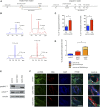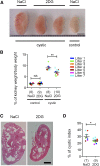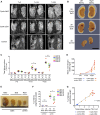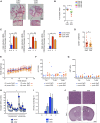2-Deoxy-d-Glucose Ameliorates PKD Progression
- PMID: 26534924
- PMCID: PMC4926967
- DOI: 10.1681/ASN.2015030231
2-Deoxy-d-Glucose Ameliorates PKD Progression
Abstract
Autosomal dominant polycystic kidney disease (ADPKD) is an important cause of ESRD for which there exists no approved therapy in the United States. Defective glucose metabolism has been identified as a feature of ADPKD, and inhibition of glycolysis using glucose analogs ameliorates aggressive PKD in preclinical models. Here, we investigated the effects of chronic treatment with low doses of the glucose analog 2-deoxy-d-glucose (2DG) on ADPKD progression in orthologous and slowly progressive murine models created by inducible inactivation of the Pkd1 gene postnatally. As previously reported, early inactivation (postnatal days 11 and 12) of Pkd1 resulted in PKD developing within weeks, whereas late inactivation (postnatal days 25-28) resulted in PKD developing in months. Irrespective of the timing of Pkd1 gene inactivation, cystic kidneys showed enhanced uptake of (13)C-glucose and conversion to (13)C-lactate. Administration of 2DG restored normal renal levels of the phosphorylated forms of AMP-activated protein kinase and its target acetyl-CoA carboxylase. Furthermore, 2DG greatly retarded disease progression in both model systems, reducing the increase in total kidney volume and cystic index and markedly reducing CD45-positive cell infiltration. Notably, chronic administration of low doses (100 mg/kg 5 days per week) of 2DG did not result in any obvious sign of toxicity as assessed by analysis of brain and heart histology as well as behavioral tests. Our data provide proof of principle support for the use of 2DG as a therapeutic strategy in ADPKD.
Keywords: ADPKD; metabolism; polycystic kidney disease.
Copyright © 2016 by the American Society of Nephrology.
Figures




References
-
- Torres VE, Harris PC, Pirson Y: Autosomal dominant polycystic kidney disease. Lancet 369: 1287–1301, 2007 - PubMed
-
- Grantham JJ, Geiser JL, Evan AP: Cyst formation and growth in autosomal dominant polycystic kidney disease. Kidney Int 31: 1145–1152, 1987 - PubMed
-
- Gattone VH 2nd, Wang X, Harris PC, Torres VE: Inhibition of renal cystic disease development and progression by a vasopressin V2 receptor antagonist. Nat Med 9: 1323–1326, 2003 - PubMed
Publication types
MeSH terms
Substances
LinkOut - more resources
Full Text Sources
Other Literature Sources
Molecular Biology Databases
Research Materials
Miscellaneous

